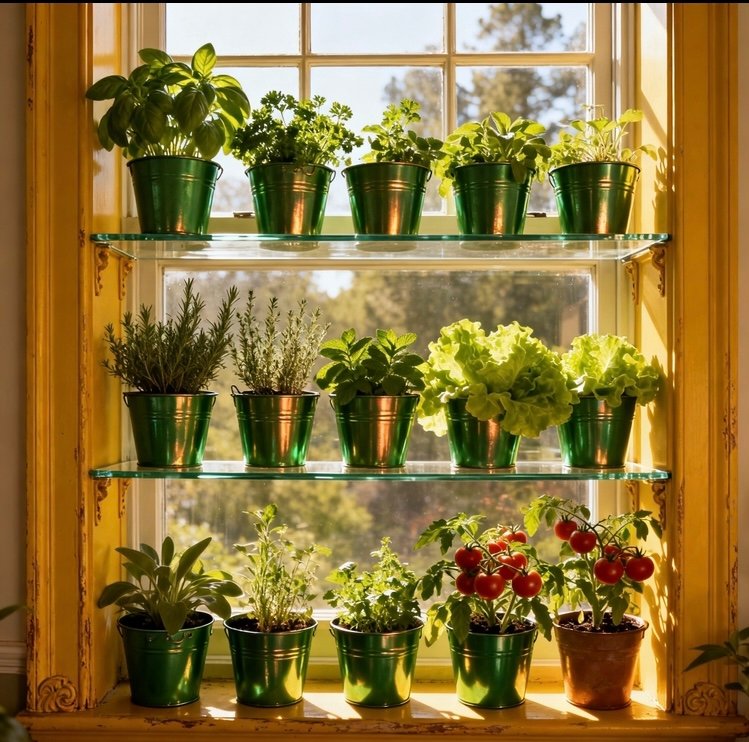Kitchen Gardens: From Windows to a Dooryard Garden

A kitchen garden doesn’t have to mean a sprawling plot behind a country farmhouse. At its heart, it’s about keeping fresh, edible plants close at hand. Whether that’s basil on your windowsill, a tower of greens by the fridge, or a traditional patch of vegetables just outside the kitchen door.
Growing food where you cook is one of the most satisfying, and sustainable ways to eat.
Why a Kitchen Garden Is Sustainable
- Cuts down food miles:
- No trucking, shipping, or packaging.
- Reduces waste:
- Harvest only what you need. No forgotten bunches of parsley turning to slime in the crisper.
- Supports pollinators (if outdoors): Herbs and vegetables flower, providing nectar and pollen. Encourages seasonal eating: You grow what thrives where you live, naturally syncing to local rhythms.
The Classic Starting Point: An Indoor Herb Garden
Most people start with herbs, and for good reason: they don’t take much space, they thrive in containers, and they give maximum flavor for minimum effort.
Best herbs for indoors:
- Basil (needs warmth and light),
- Parsley(steady grower),
- Chives (snip and they regrow),
- Thyme and oregano (hardy, drought-tolerant),
- Mint (vigorous, but best in its own pot to prevent takeover)
Setups for small kitchens:
- Windowsill pots: Ideal if you’ve got a sunny ledge.
- Magnetic planters: Stick to the fridge door, your herbs are right where you cook.
- Vertical wall racks: Mason jars or fabric wall planters keep herbs up and off the counter.
- Countertop hydroponics kits: More expensive, but reliable for low-light apartments.
Beyond Herbs: What Else Can You Grow Indoors?
Not everything is suited for the kitchen, but some edibles do surprisingly well in containers under the right conditions.
- Lettuces and salad greens: Shallow roots, quick turnaround.
- Green onions (scallions): Regrow store-bought roots in a jar of water, then pot them up.
- Microgreens, such as radish, arugula, sunflower, and pea shoots, provide nutrient-dense greens in just 7–10 days.
- Dwarf peppers or tomatoes: They need strong light or grow lights, but it’s rewarding if you’ve got the space.
- Strawberries: Compact and happy in hanging baskets near a bright window.
Tip: Indoor fruiting plants need more light than leafy ones—grow lights may be necessary in Canadian winters.
When the Kitchen Is Just Too Small
Not every kitchen can spare counter or windowsill space. If you’re working with a galley kitchen or a cluttered apartment setup, consider moving the garden just outside the kitchen:
- Window boxes: Perfect for herbs, lettuce, or strawberries. Easy to snip while you cook.
- Balcony planters: Larger containers can hold peppers, beans, or dwarf tomatoes.
- Vertical gardens: Use a pallet, trellis, or modular planter system to grow upwards, not outwards.
The Old-Fashioned Kitchen Garden
Traditionally, the kitchen garden (or “potager”) sat just steps from the back door, packed with herbs, vegetables, and a few flowers for beauty and pollinators. Even if you don’t have much space, a raised bed or a few large containers outside the kitchen can revive the idea.
Good choices for a kitchen garden bed:
- Leafy greens (lettuce, kale, spinach)
- Root crops (radishes, carrots, beets)
- Tomatoes (classic, versatile, and high-yield) Zucchini (prolific, one or two plants are enough)
- Pole beans (climb a trellis to save space)
- Perennial herbs (chives, oregano, sage) for low-maintenance flavor
Design tip: Mix in flowers like marigolds, nasturtiums, or calendula. They attract pollinators, deter pests, and make the garden beautiful enough to be part of your outdoor living space.
Kitchen gardens don’t have to be big or complicated. A few pots of herbs, a tray of lettuce, or a raised bed outside your door all count. The beauty of the kitchen garden is flexibility—it adapts to your space, your cooking style, and your climate.
Start small. Plant what you know you’ll use often. And remember: even a sprig of fresh basil from your own windowsill feels more satisfying (and sustainable) than a plastic clamshell flown in from who-knows-where.
